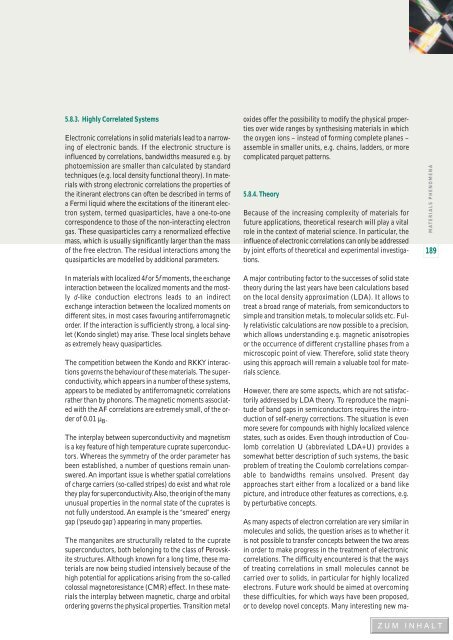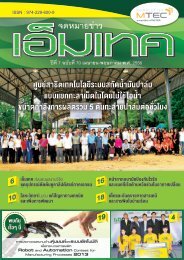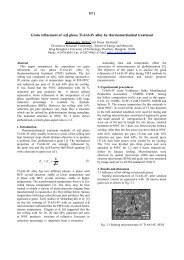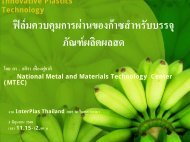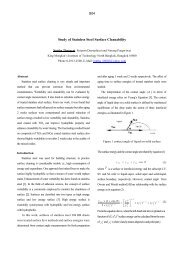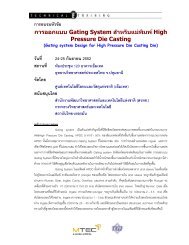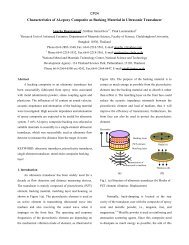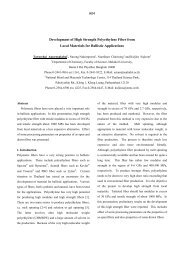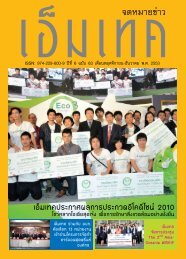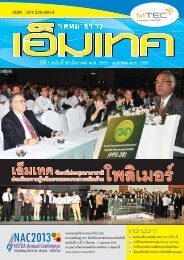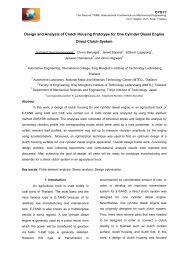EUROPEAN WHITE BOOK
EUROPEAN WHITE BOOK
EUROPEAN WHITE BOOK
You also want an ePaper? Increase the reach of your titles
YUMPU automatically turns print PDFs into web optimized ePapers that Google loves.
5.8.3. Highly Correlated SystemsElectronic correlations in solid materials lead to a narrowingof electronic bands. If the electronic structure isinfluenced by correlations, bandwidths measured e.g. byphotoemission are smaller than calculated by standardtechniques (e.g. local density functional theory). In materialswith strong electronic correlations the properties ofthe itinerant electrons can often be described in terms ofa Fermi liquid where the excitations of the itinerant electronsystem, termed quasiparticles, have a one-to-onecorrespondence to those of the non-interacting electrongas. These quasiparticles carry a renormalized effectivemass, which is usually significantly larger than the massof the free electron. The residual interactions among thequasiparticles are modelled by additional parameters.oxides offer the possibility to modify the physical propertiesover wide ranges by synthesising materials in whichthe oxygen ions – instead of forming complete planes –assemble in smaller units, e.g. chains, ladders, or morecomplicated parquet patterns.5.8.4. TheoryBecause of the increasing complexity of materials forfuture applications, theoretical research will play a vitalrole in the context of material science. In particular, theinfluence of electronic correlations can only be addressedby joint efforts of theoretical and experimental investigations.MATERIALS PHENOMENA189In materials with localized 4f or 5f moments, the exchangeinteraction between the localized moments and the mostlyd-like conduction electrons leads to an indirectexchange interaction between the localized moments ondifferent sites, in most cases favouring antiferromagneticorder. If the interaction is sufficiently strong, a local singlet(Kondo singlet) may arise. These local singlets behaveas extremely heavy quasiparticles.The competition between the Kondo and RKKY interactionsgoverns the behaviour of these materials. The superconductivity,which appears in a number of these systems,appears to be mediated by antiferromagnetic correlationsrather than by phonons. The magnetic moments associatedwith the AF correlations are extremely small, of the orderof 0.01 µ B .The interplay between superconductivity and magnetismis a key feature of high temperature cuprate superconductors.Whereas the symmetry of the order parameter hasbeen established, a number of questions remain unanswered.An important issue is whether spatial correlationsof charge carriers (so-called stripes) do exist and what rolethey play for superconductivity. Also, the origin of the manyunusual properties in the normal state of the cuprates isnot fully understood. An example is the “smeared” energygap (‘pseudo gap’) appearing in many properties.The manganites are structurally related to the cupratesuperconductors, both belonging to the class of Perovskitestructures. Although known for a long time, these materialsare now being studied intensively because of thehigh potential for applications arising from the so-calledcolossal magnetoresistance (CMR) effect. In these materialsthe interplay between magnetic, charge and orbitalordering governs the physical properties. Transition metalA major contributing factor to the successes of solid statetheory during the last years have been calculations basedon the local density approximation (LDA). It allows totreat a broad range of materials, from semiconductors tosimple and transition metals, to molecular solids etc. Fullyrelativistic calculations are now possible to a precision,which allows understanding e.g. magnetic anisotropiesor the occurrence of different crystalline phases from amicroscopic point of view. Therefore, solid state theoryusing this approach will remain a valuable tool for materialsscience.However, there are some aspects, which are not satisfactorilyaddressed by LDA theory. To reproduce the magnitudeof band gaps in semiconductors requires the introductionof self-energy corrections. The situation is evenmore severe for compounds with highly localized valencestates, such as oxides. Even though introduction of Coulombcorrelation U (abbreviated LDA+U) provides asomewhat better description of such systems, the basicproblem of treating the Coulomb correlations comparableto bandwidths remains unsolved. Present dayapproaches start either from a localized or a band likepicture, and introduce other features as corrections, e.g.by perturbative concepts.As many aspects of electron correlation are very similar inmolecules and solids, the question arises as to whether itis not possible to transfer concepts between the two areasin order to make progress in the treatment of electroniccorrelations. The difficulty encountered is that the waysof treating correlations in small molecules cannot becarried over to solids, in particular for highly localizedelectrons. Future work should be aimed at overcomingthese difficulties, for which ways have been proposed,or to develop novel concepts. Many interesting new ma-


